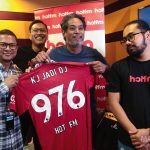FOMO (fear of missing out) is a feeling that is commonly despised by the millennials. The constant fear of being left behind is real in this digital age. Hence, needing to be informed, updated, and staying connected are no longer wants – all three are now necessities, especially now with the COVID-19 pandemic causing worldwide disruption. This is more so for millennials and digital natives who are always on-the-go and have this need to be aware of the latest news, trends and consume information instantly.
Once thought to be a laggard among the electronic broadcast media, radio has matched these needs on many levels and is now on its comeback run. Last year, GfK’s Radio Audience Measurement revealed how more millennials in Malaysia, are tuning into local radio stations and chasing after new content on this broadcasting pioneer. This has contributed to the overall audience growth in 2019, especially among those aged between 20 to 29.
In terms of weekly reach, that translates to 4.8 million users – an increase of 3% from the previous year. On average, roughly 20.6 million Malaysians from the Peninsular alone are listening to the radio.
What do these growth statistics mean? – It means more Malaysians, especially the youths, are turning back to live broadcasting content. In fact, GfK also shared how both weekday and weekend programming are seeing increases as well.
What sort of content are they tuning to the radio for? – Interestingly, based on various surveys that GfK and other trend studies carried out, there are three primary drivers:
- Wanting to hear/listen to songs that audiences are familiar with and enjoy them
- Discover new songs that are trending on charts or popular on the airwaves
- To be updated on current news and learn what are the hot topics of the hour
“It is heartening that younger Malaysians are listening to the radio and engaging with radio advertisements by searching for products online. According to him, this shows that radio advertising can be an effective marketing strategy to raise brand awareness and top of mind recall, which – as a result, increases sales conversions on digital platforms,” said Ozarizan Mohd Nor, President of Commercial Radio Malaysia.
Sustained Influence
As a pioneer in the broadcasting space, there is no doubt that radio is a major influence during its prime. While most presume radio would falter during the TV boom and then bow out to streaming content in the digital era, the opposite happened. Now, more than ever, radio continues its domination as an influential electronic and broadcasting medium. In fact, in recent weeks, radio is the immediate go-to for any breaking news, specifically on COVID-19, as fake news and rumour-mongering continue to dominate social media.
As is, radio is often used as a multi-tasking medium, accompanying listeners throughout the day while they are doing their daily routines. In a way, radio can subliminally influence listeners, making it a viable platform for curated content and marketing campaigns.
Even in the age of digital transformation, radio is still the go-to for authentic, verified, and trustworthy content. It continues to strive in delivering this sincerity since its sources consist of major newspapers and news wires. This, according to GfK, from its 2018 Radio Insights Malaysia study, is due to how youths believe this platform can provide a sense of companionship (49% survey respondents) and feel connected to a community (47% from the research).
Both sentiments reflect strongly on the digital front as clippings, podcasts, and managed programming from radio are now being shared on social media. This further reinforces the fact that this medium is both pervasive and prevalent. In fact, programming and content on radio is no longer just music, the news, and random host commentary – it has adapted with the times and integrated next-gen content innovations and, in turn, can produce content for on-air, online, and on-ground use.
“Today, with its holistic approach to engagement, radio is effective in driving a mass pool of listeners to on-ground events, radio broadcasters’ websites, mobile apps and social media pages,” Ozarizan added.
Engaging Audience Outreach

Among the most proactive in creating multi-tiered and multi-platform content for radio’s varied outlets for Malaysia is Astro Radio. From when it first started its original content production, the programming for all Astro Radio platforms have grown to become very extensive. In fact, it even produces content that goes beyond its primary platform as these materials can be repurposed for online and digital broadcast use.
In doing so, Astro Radio now has an audience reach that is expansive and constantly engaged. New efforts for the progressive radio arm include the introduction of the SYOK mobile radio app last year. Designed as a one-stop entertainment and lifestyle platform, SYOK is the primary platform for Astro Radio listeners who want to keep up with its live radio channels, original and exclusive content, SYOKcasts (podcasts) and amazing contests to win cool prizes.
SYOK was created to address the growing needs of users who are tech savvy and always on the go. Within the first six months, it managed to attract 250,000 monthly-active-users (MAUs). As is, with SYOK, and its other various efforts, Astro Radio captured 82% of the youths who prefer listening to the radio. This translates to 16.7 million listeners and millions more in followers and interactions on its social media and digital platforms.
One of Astro Radio’s most successful campaigns last year was ‘Personaliti Top ERA Milo’ – a platform that discovered popular radio names such as Radin and Hani Fadzil. Designed to uncover radio’s next big names, it managed to draw in more than 500 submissions via the web and Instagram for 2019. From that, 12 finalists were shortlisted and tasked with various challenges like script writing, social media content development, and on-air assignments.
To ensure that clients are kept at the top of mind of consumers, Milo was also integrated in all the challenges. All 12 competed to see who can become ERA’s next radio host/personality and, at the same time, assist clients to promote their brands.
In terms of advertising performance, research from Commercial Radio Australia shows how listeners react. Once they hear a brand on the air, they are seven times more likely to look for a specific brand on the web, interact with the social media platform of brands, or follow the call-to-action online within 24-hours.
Undoubtedly, radio is still a trailblazer – from being a pioneer to now taking lead on integrating itself with disruptive innovation. This has paved the way for radio content where it now produces original productions, craft creative advertisements, and develop special-hosted programmes.
In doing all this, radio has managed to remain at the forefront of broadcasting media – especially during this trying time, in ensuring listeners are well updated on the COVID-19 pandemic whilst keeping them calm and entertained. With how radio faced new media multiple times and quickly adapted or enhanced itself, it’s clear that the original broadcasting medium is stepping up and not taking things lying down.
MARKETING Magazine is not responsible for the content of external sites.
Join the MARKETING HOME OF FAME at the Malaysian Marketing Conference Discovery Edition on May 9th.
Learn more at https://marketingmagazine.com.my/cmo2025/
Proudly sponsored by MRT Corp and Media Prima Omnia
For bookings: ruby@adoimagazine.com
BOOK SEATS NOW










